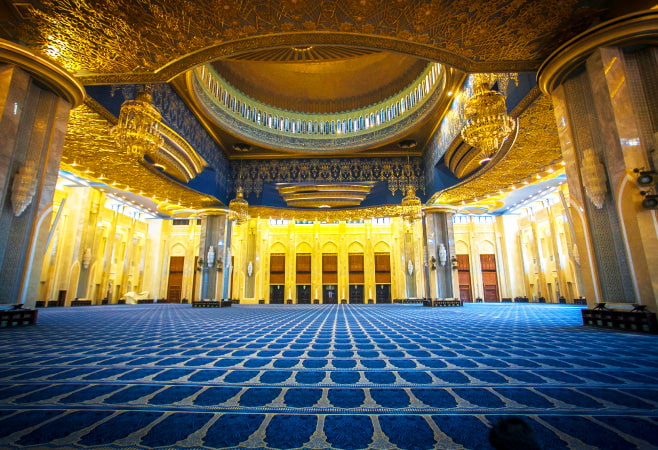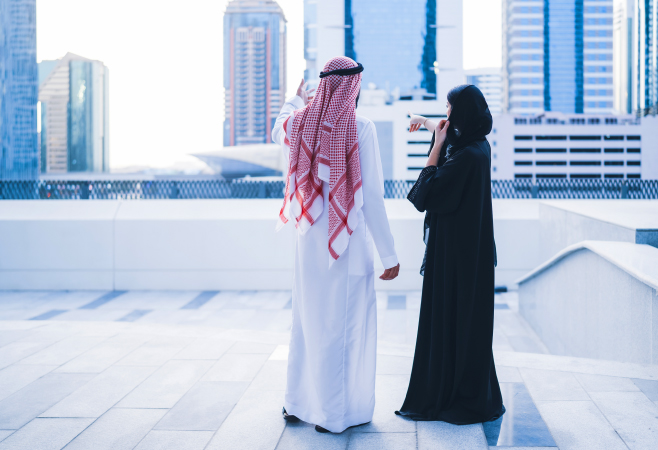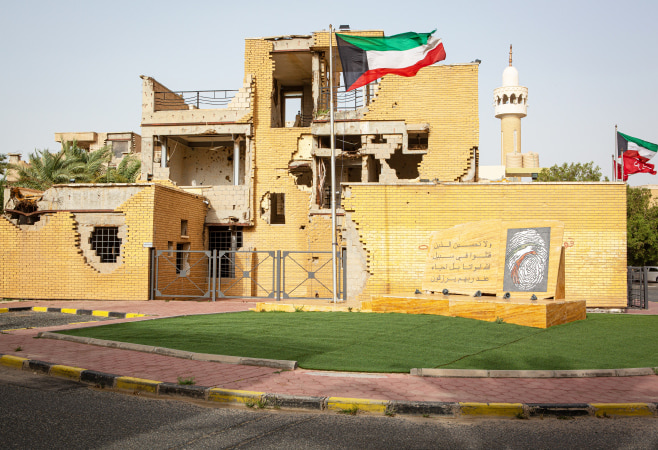Grand Mosque of Kuwait: A Spiritual and Architectural Icon of the Nation
In the heart of Kuwait City lies a breathtaking symbol of faith, architecture, and national identity — the Grand Mosque of Kuwait. Known locally as Masjid Al-Kabir, this majestic structure isn’t just the largest mosque in the country; it’s also a cultural landmark that represents Kuwait’s Islamic heritage, architectural brilliance, and welcoming spirit.
The Grand Mosque of Kuwait is a must-visit place regardless of whether you are an architecture enthusiast, a religious traveler, or just someone who is out to experience the cultural jewels of Kuwait. In this comprehensive guide, we will show you its history, design, meaning, and how to visit it, and we will give you some practical tips, all in an endeavor to make you experience this memorable place.
- 1. A Brief History of the Grand Mosque
- 2. Architectural Marvel of Kuwait
- 3. Cultural and Religious Significance
- 4. Visiting the Grand Mosque: What You Need to Know
- 5. Location and How to Get There
- 6. What Visitors Say
- 7. Combining the Mosque with Other Landmarks
- 8. Do You Need a Visa to Visit?
- 9. Final Thoughts
1. A Brief History of the Grand Mosque
The Grand Mosque of Kuwait was constructed in 1986 and fully financed by the Kuwaiti government in order to demonstrate the national pride and religious commitment of the people of Kuwait. In spite of the hundreds of mosques in Kuwait, there is nothing of this magnitude, beauty, and importance as this marvel of a building.
During the Islamic holy month of Ramadan and important national celebrations, the mosque plays host to thousands of worshippers, dignitaries, and guests. Its importance goes beyond religion; it serves as a unifying space for the Kuwaiti people.
2. Architectural Marvel of Kuwait
The mosque complex covers over 45,000 square meters, and the main prayer hall accommodates about 5,000 worshippers. During major occasions, the entire mosque, including the courtyards, can host over 10,000 people. The mosque is a demonstration of a combination of conventional Islamic architecture and modernity, which includes
- A main dome adorned with intricate geometric patterns
- A 109-meter minaret visible across downtown Kuwait
- Lavish use of calligraphy, marble, teak wood, and decorative tiles
- A separate prayer hall for women, library, and large Islamic study center
The interior is serene yet grand, with low lighting and gentle colors that evoke a sense of peace. Visitors often compare its elegance to famous mosques in Istanbul and the Gulf.
 Inside the Fabulous Grand Mosque of Kuwait
Inside the Fabulous Grand Mosque of Kuwait
3. Cultural and Religious Significance
Being the main mosque in the country, the Grand Mosque of Kuwait is the center of religious life in the country. This is the place where the Emir of Kuwait comes to Eid prayers and also a center of attraction during Ramadan Taraweeh prayers, where thousands of people come together every night to offer prayers.
Moreover, the mosque is a center for Islamic education, regularly hosting lectures, Quran recitations, and interfaith discussions. It embodies Kuwait’s commitment to Islamic values, tolerance, and unity.
 Kuwaiti citizens comes to prayers
Kuwaiti citizens comes to prayers
4. Visiting the Grand Mosque: What You Need to Know
Free Guided Tours
Among the most favorite aspects of the Grand Mosque of Kuwait is the fact that it is accessible even to non-Muslim visitors on guided tours. These tours are absolutely free and are conducted in English and Arabic.
Well-informed guides take visitors through the main prayer hall, library, conference hall, and courtyard, explaining the Islamic traditions and the architecture.
If you’re planning a grand mosque kuwait tour, remember to book in advance. Tours are usually available between 9:00 AM and 12:00 PM (Sunday to Thursday), excluding Fridays and religious holidays.
Dress Code & Etiquette
- Modest clothing is required. Women are provided with abayas and headscarves upon entry.
- Remove your shoes before entering the prayer hall.
- Photography is generally allowed, but always ask your guide for specific rules.
- Visitors are asked to remain respectful, quiet, and attentive throughout the visit.
 Dress Code at Kuwait
Dress Code at Kuwait
5. Location and How to Get There
The Grand Mosque, Kuwait, is situated close to Seif Palace and the National Assembly, which means it is well connected to any part of Kuwait City. It is located on the Arabian Gulf Road, and other major landmarks near it include:
- Seif Palace
- Kuwait National Museum
- Souq Al-Mubarakiya
- Kuwait Bay Waterfront
Taxi, ride-hailing apps, and hotel shuttles are convenient ways to reach the site. Parking is available, and entry to the mosque is completely free.
6. What Visitors Say
According to grand mosque of kuwait reviews on TripAdvisor, Google, and Lonely Planet, the mosque receives praise not only for its beauty but also for the quality of its guided tours. Visitors frequently highlight:
- The warmth and knowledge of the tour guides
- The peaceful atmosphere inside the prayer halls
- The informative introduction to Islam, especially for non-Muslims
- Cleanliness and hospitality
This has made the mosque as one of the most advised landmarks to visit in Kuwait, particularly by culture-oriented travelers and those seeking religious enlightenment.
7. Combining the Mosque with Other Landmarks
If you’re planning a cultural itinerary in Kuwait City, consider combining your Grand Mosque tour with nearby attractions such as:
- Tareq Rajab Museum (featuring Islamic art and rare manuscripts)
- Sadu House (highlighting Bedouin weaving traditions)
- Al-Qurain Martyrs House (offering insight into Kuwait’s resistance during the 1990 invasion)
For longer day trips outside the city center, you can plan separate visits to:
- Failaka Island, which requires advance boat booking and half-day to full-day scheduling
- Red Fort (Al Jahra), located approximately 30 km from the city, known for its role in the Battle of Jahra
These combined experiences provide a fuller understanding of Kuwait’s spiritual, artistic, and historical identity.
 The Al-Qurain Martyrs Museum
The Al-Qurain Martyrs Museum
8. Do You Need a Visa to Visit?
Yes — most international travelers need a valid visa to enter Kuwait, including those planning a grand mosque of kuwait tour.
Fortunately, you can apply online easily with Kuwait Immigration Services. They offer:
- Fast eVisa processing
- 100% online application
- Real-time status tracking
- Expert support for visa questions and documentation
Do not allow documents to slow down your faith experience—submit your application today and get ready to visit the Grand Mosque of Kuwait personally.
9. Final Thoughts
The Grand Mosque of Kuwait is more than just a religious structure, as it is essentially a national asset, an architectural masterpiece, and the key to deciphering the Kuwaiti identity. You will not be disappointed about having visited it, seeing the soaring dome, hearing the recitation of the Quran, or learning more about Islamic traditions with the help of local guides; anyway, your experience will be valuable and unforgettable.
So, if you’re seeking beauty, serenity, and culture on your trip to Kuwait, don’t miss the chance to step inside the grand mosque kuwait — and experience the soul of a nation.
Start your journey today by applying for your Kuwait eVisa at Kuwait Immigration Services – fast, official, and traveler-trusted.
Related Articles
- Street Food in Kuwait – Exploring the Authentic Flavors of the Gulf
- Arts and Crafts Kuwait – Discovering the Soul of Creativity in the Gulf
- Current Kuwait Currency – The World’s Strongest Currency Explained (Updated 2025)
- Live Music in Kuwait – Discover the Sound of the Arabian Gulf (Updated 2025)
- Water Parks in Kuwait – Splash into Fun Under the Arabian Sun (Updated 2025)
- The Ultimate Kuwait Itinerary: A Journey Through Culture, History, and Modernity
- Kuwait Food Culture: A Rich Culinary Journey through Tradition and Innovation
- Kuwait Adventure Activities: Thrills Beyond the Desert
- Budget Kuwait: Your Guide to Affordable Travel in the Gulf
- Festivals in Kuwait: A Colorful Journey Through Culture and Celebration
HOW CAN WE HELP?
APPLY WITH CONFIDENCE
|










